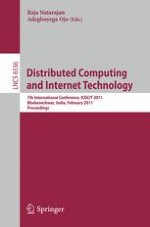2011 | Buch
Distributed Computing and Internet Technology
7th International Conference, ICDCIT 2011, Bhubaneshwar, India, February 9-12, 2011. Proceedings
herausgegeben von: Raja Natarajan, Adegboyega Ojo
Verlag: Springer Berlin Heidelberg
Buchreihe : Lecture Notes in Computer Science
